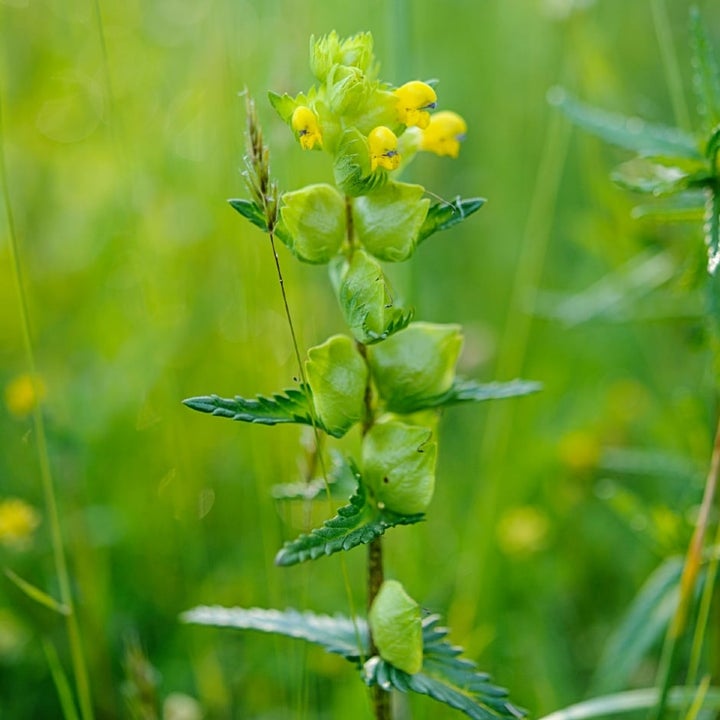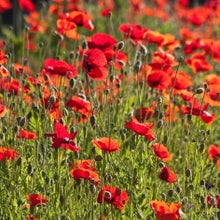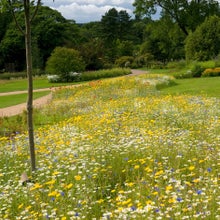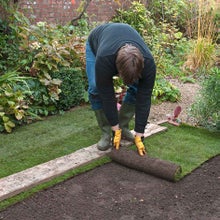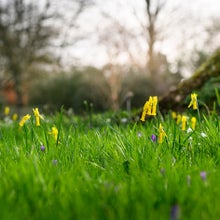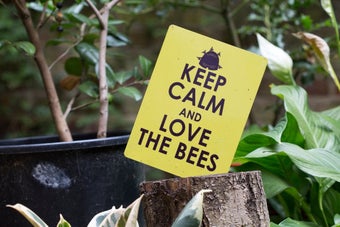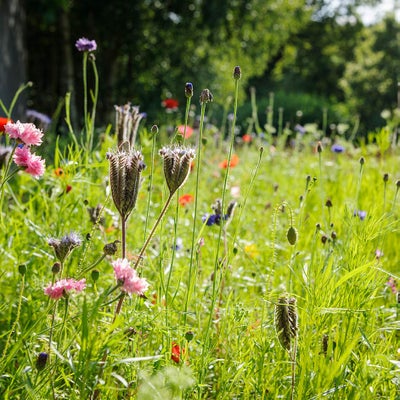
Quick facts
There are two main types of wildflower meadow – annual meadows where plants complete their life cycle within one year, and perennial meadows where plants grow back year after year
You can create a meadow by sowing wildflower seeds, laying wildflower turf or converting an existing lawn
Mid-spring or early autumn is the best time to sow wildflower seeds, and spring is the best time to lay turf
It's important to choose a mix of wildflowers suited to your soil type and location
What type of wildflower meadow?
meadows can be any size – even a small patch of ground or part of a border can be transformed into an attractive and valuable pollinator-friendly mix of grasses and wildflowers. This can be fitted easily into most gardens and is a good starting option. But if you have the space, a large wildflower meadow can look spectacular.
Wildflower meadows usually flower between May and September, and attract a wide range of pollinators. You can also buy seed mixes tailored for specific wildlife, such as butterflies, bees or seed-eating birds.

There are lots of meadow seed mixes available, with different combinations of flowers and grasses. The main choice is between an annual or mix:
- Annual meadows are usually a mix of colourful cornfield such as cornflowers, field poppies, corn marigolds and corncockles, often with some barley and wheat too. The plants grow quickly and easily from seed, and flower in just a few months. After flowering, they scatter their seeds and die. If you want to repeat the display the following year, new plants will grow from the fallen seeds, although additional sowings may be needed. Don’t fertilise your soil in the months before sowing, and choose a seed mix that’s suited to your soil type and location
- Perennial meadows generally take longer to establish – most take at least two years to flower well from seed, but then continue for years to come. They can contain a wide range of species including ox-eye daisies, red campion, knapweed and field scabious. Choose a seed mix that’s suited to your site and soil type – some like fertile soil (such as clovers and lady’s smock), while others are less fussy (such as ox-eye daisies and ragged robin).
Some wildflower meadow mixes combine both annuals and . Some meadow mixes also include non-native and cultivated species, which can be equally attractive and just as beneficial to wildlife.
For inspiration, see our guide to five easy annual wildflowers.
If you don’t want to create a new meadow from scratch, you can instead convert your lawn or simply encourage more diversity of wild plants within a mown lawn – see How to transform an existing lawn, below, for these options.

Buying meadow seeds
You can buy standard wildflower meadow seed mixes in most garden centres and from online seed suppliers, ideal for sowing small areas. There are also many specialist wildflower seed merchants selling a wider choice of wildflower and grass mixes suitable for larger areas and for various soil types and locations.
Choose a seed mix that suits your conditions. Where possible, buy seed of British origin, especially for wildflowers, and always from reputable suppliers.
Protecting wild habitats
Never dig up wild plants from the countryside without prior permission from the landowner. Collecting seeds of certain rare or threatened species, or in specifically protected areas, may also be illegal. See the Wildlife and Countryside Act (1981) for full details.
When and where to sow
Most meadow seed mixes can be sown in early to mid-spring (March/April) or early autumn (September), but check packets for details. On lighter soil, autumn-sown seeds generally germinate and establish quickly, although some won’t come up until the following spring. If you have heavy soil, which tends to stay wet and cold over winter, it’s better to wait until spring to sow.
Most meadow plants need full sun and well-drained soil. However, tailored seed mixes for other locations, such as semi-shade, damp or dry soil, and coastal sites, are available from specialist suppliers.
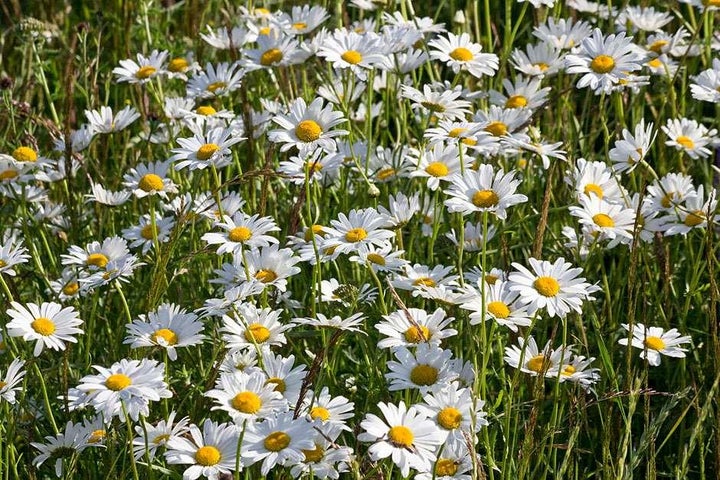
How to sow wildflower seeds
To create a meadow from seed, you need to start with bare, weed-free ground. Sowing seeds directly into a lawn is rarely successful – even if they germinate, the resulting will have to compete with the existing dense turf and are unlikely to survive. (If you want to add wildflowers to your lawn, see How to transform an existing lawn, below.)
There is no need to fertilise the area, whether your soil is fertile or poor – just make sure you’ve selected a meadow seed mix that suits your soil type.
Sowing a small area of annual wildflowers is easyand minimal soil preparation is required. Simply choose a patch of spare ground, such as a gap in a border or a new bed, and follow the steps in our handy how-to guide:
meadows need more thorough preparation, in a similar way to new lawns, and this should be done several months in advance.
It is firstly important to reduce the fertility of the soil, so wildflowers don't get overwhelmed by vigorous grasses. There are two main options:
- Remove the top layer of soil to reveal the less fertile sub-soil. This can be done by hand in small areas or using a digger or landscape contractor on larger sites.
- Sow mustard or oil-seed rape for a season to use up some of the nutrients, removing the plants before they set seed. This is mainly for large areas, but not clay soil or those rich in organic matter
You should then thoroughly weed and prepare the soil:
- It’s important to remove vigorous perennial weeds such as nettles and docks – dig out by hand, removing all the roots. See our advice page on non-chemical weed control
- Fork over the soil to break up any compaction or lumps, and firm it by treading the area using small shuffling steps
- Leave the soil to settle, ideally for four to six weeks, which also gives time for any weed seeds to germinate. Hoe these off, then rake to create a level surface with a fine, crumb-like texture

Aftercare
- If it doesn’t rain, water small areas of wildflowers regularly until the young plants are well-rooted
- Watering larger meadow areas is not really viable or a good use of water, so it’s best to just rely on rainfall
- Over the first summer, regularly remove any obvious weeds that are not in the seed mix, especially in smaller-scale meadows. This helps to ensure that more delicate wildflowers aren’t outcompeted by too many vigorous species
For advice on cutting your new meadow, see our guide:
How to lay wildflower turf
An easier, although more expensive, way to create a meadow from scratch is to lay wildflower-rich turf onto prepared ground. This is increasingly available from specialist turf and wildflower suppliers, and comes on short rolls in the same way as conventional lawn turf.
It’s a useful alternative to sowing seed, especially if you want fast results or if the site contains high levels of weed seeds (as they’re less likely to germinate through a layer of turf). The higher cost usually means it’s only suitable for small wildflower areas, and the choice of different wildflower mixes is also more limited.
Wildflower turf is often grown on plastic mesh, so it doesn’t fall apart while being transported. However, it’s now possible to buy turf on a plastic-free felt base, which is more environmentally-friendly.
Prepare the ground in the same way as for wildflower meadow seeds – see above. Although you can lay wildflower turf all year round, spring is the best time. Keep it well-watered throughout the first summer while it establishes.
How to transform an existing lawn
Lawns can be turned into ‘meadows’ in several ways, depending on how much time and effort you want to put in and the result you want to achieve:
- The easiest option is to simply leave some, or all, of your lawn unmown, to let the grass grow long, where any wildflowers already present will be able to grow up and flower
- Another easy option is to plant low-growing wildflowers and spring in your lawn to create a flower-rich mown lawn
- The third option is to convert a lawn into a wildflower meadow, which can be done over several years
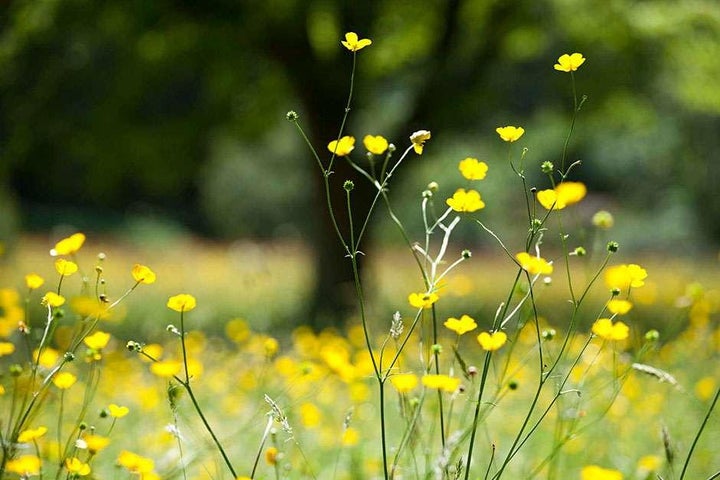
Let the grass grow long
If you simply stop mowing your lawn, ideally in spring, then plants that were traditionally considered lawn weeds, such as buttercups, dandelions and yarrow, will get the chance to flower among the grass.
You can get a surprisingly diverse array of wildflowers appearing and attract lots of pollinating insects, although the area will still be predominantly grass. The grasses themselves will also flower and produce seedheads, which can be very attractive and provide nutritious food for wildlife, as well as sheltered habitats.
You can leave your whole lawn to grow long, or just certain areas that aren’t often used. You can mow paths through the long grass too, to make the area more accessible. And the long grass can be returned to lawn whenever you like, by strimming and then reinstating a regular mowing routine.
No Mow May is an ideal way to try this out. Stop mowing for the whole of May and the wild plants already in your lawn will grow up and flower, adding colour and attracting pollinating insects and other wildlife. You can leave your whole lawn uncut or just a section.
Then either re-start mowing in June or leave the grass uncut until August to encourage a greater diversity of plants. Find out more about No Mow May from the campaign organiser, Plantlife.
If you find this works well, you can go on to properly convert your lawn, or certain areas of it, into a more well-balanced meadow – see Convert a lawn into a wildflower meadow, below.
Create a flower-rich mown lawn
To boost the flowers in a regularly mown lawn, you can add young plants of low-growing species such as daisies, ajuga, selfheal, dog violets and clover, which can either cope with mowing or duck below the blades. Let the grass grow a little longer than a traditional lawn to ensure they thrive.
Shade-tolerant primroses can also be added to thinner areas of grass under trees.
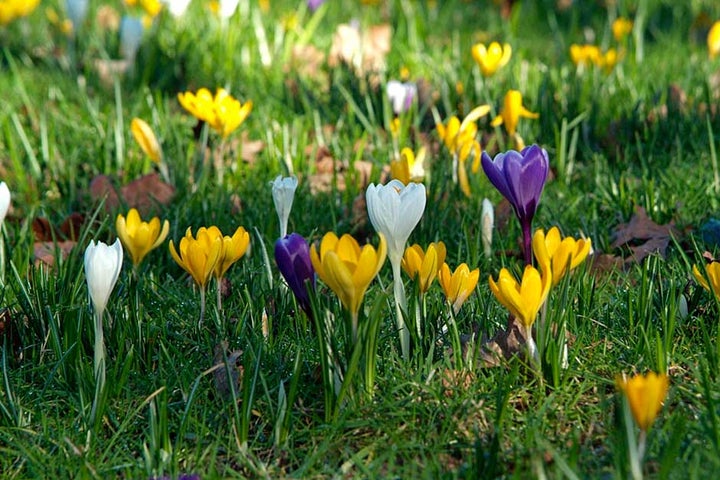
Another great way to add colour and to lawns is to plant spring-flowering bulbs under the turf in autumn, such as snowdrops, crocuses and daffodils. These provide valuable nectar for early bees and a welcome splash of colour. Bear in mind that you’ll need to stop mowing areas of bulbs for several months, from when the leaves start to appear until they die back after flowering. So bulbs are best planted in specific areas rather than across the whole lawn. See our planting guide:
Convert a lawn into a wildflower meadow
It can take a number of years to convert a lawn into a well-balanced mix of grass and wildflowers, as initially the soil will be too fertile, allowing vigorous grasses to dominate. The fertility needs to be reduced gradually over several years:
- Stop feeding or applying weedkiller to your lawn – this will allow wild species to start appearing naturally
- In the first year, continue mowing weekly, to weaken the grass, and remove the clippings
- Use this first year to start raising perennial wildflowers from seed in pots or trays, to be planted out as one- or two-year-old plants
- The following spring, leave the grass uncut, and follow the care routine in our meadow maintenance guide
- Start adding the wildflower plants you’ve grown, or bought, directly into the grass. For a natural look, plant in small groups of the same species
- Removing all the plant material each time you cut the meadow will gradually reduce the soil fertility

Problem solving
Grasses can be very vigorous and may outcompete more delicate wildflowers. To reduce the vigour of established grass, introduce semi-parasitic plants. These include rattle (Rhinanthus species), eyebright (Euphrasia species)and lousewort (Pedicularis palustris and P. sylvatica).
The most useful is yellow rattle – in late summer or autumn, scatter the seeds onto grass that has been cut short. This is an annual, so make sure you allow it to scatter its seeds, to ensure it keeps appearing every year. You can buy yellow rattle from RHS Plants online.
